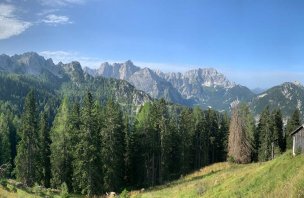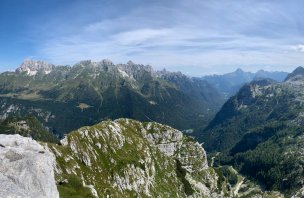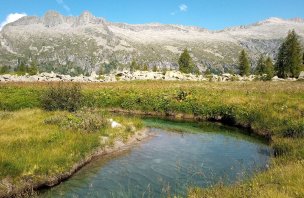Circular trek in the Brenta Mountains with the Osvaldo Orsi light ferrata
Mountain range, region / State
Brenta / Italy
Season
Fall
24. 10. - 27. 10. 2016
Difficulty
3 / 5
Elevation
↑ 2349 m
↓ 2349 m
Length
18.9 km
4 days
Altitude
max. 2650 m n.m.
min. 1521 m n.m.
Tips for hikes in the country Italy

Trek to the Cima del Cacciatore from Monte Lussari

Trek to Bila Pec from Sella Nevea in Italy

Attempt to climb Cima Cop di Breguzzo
Three-day trek on easy secured trails in the Brenta Mountains
Starting point
From the village of Madonna di Campiglio, the best parking option is about three kilometres from Madonna di Campiglio at the Rifugio Vallesinella hut. It is one of the best starting points to Brenta. Parking at the chalet was free at the time of our visit.
Description of the hike
1. day
We started from the parking lot of the Vallesinella hut around 8am and our plan was to walk only to the Tuckett saddle which is about 1,100 meters of elevation gain. We didn't make it there because we were tempted by the cozy winterraum after arriving at the Tuckett hut and so we didn't continue that day.
The trail is marked in typical alpine style, i.e. a red circle with a white dot in the middle and directional signs with the trail number. The markings are in very good condition and the orienteering is therefore without problems. The trail is easy without difficult sections, the elevation from the parking lot to the hut is about 750 m. From the Tuckett hut there is a beautiful view of the Adamello - Presanella mountain massifs up to Ortler.
2. day
The next day we started at 5 am to catch the sunrise at Tuckett Saddle. The trail is initially uneventful, with minor difficulties after reaching the Tuckett Glacier at the end of the valley. The glacier, or rather the rest of it, is quite steep, we didn't need crampons (soft snow) but they would have been useful in worse conditions. At the Tuckett saddle the Via delle Bocchette ferrata crosses and the Osvaldo Orsi easy ferrata, route number 303, which we also took, begins.
From the Tuckett saddle the descent is secured by a rope but it is absolutely trouble-free. There is no need to belay, the rope is just a psychological support. The whole Osvaldo Orsi route is described as a ferrata of A/B difficulty. It is beautifully led in the eastern side of the Brenta Mountains. During the route there are beautiful views of Lago di Molveno, the Paganella massif which is more familiar to skiers and basically the whole Dolomites. In the first third of the way we reach a notch under the Sega Alta rock. Here is the narrowest point of the whole trek, a shelf about a meter wide secured by a rope. Passing through this place is without problems but it will be different in wet weather, not to mention snow or ice. Resistance to vertigo is a matter of course here.
We continue without difficulty along a comfortable path with still beautiful views of the Brenta massif, especially the Campanila Basso needle. After reaching the huts of Tosa and Pedrotti, you need to turn into the Bocca di Brenta saddle. Below the saddle, a short detour (50 m.) to the abundant water spring. From the saddle you can see the goal of the day, the Brentei hut, which is only an hour away. Of course, the whole route can be completed in two days. But if you want to enjoy sunrises and sunsets in the mountains, it is better to extend the route by one day and enjoy it high in the mountains than in a parking lot in the forest.
We slept in the attic of the freight cableway to the Brentei hut, which was freely accessible at the time of our visit. Otherwise there is a winterraum and plenty of space for a tent. About a hundred meters above the Brentei hut is a stone chapel as a symbolic cemetery for the victims of the mountains. From the hut there is a great view of the Crozzon di Brenta and Cima di Tosa.
3. day
The next morning, we descended back into the Vallesinella valley on the comfortable trail #318 and were back at the parking lot in two hours. The Mezzo Falls are worth mentioning, about a ten minute walk from the Vallesinella hut car park. The whole route can be done in two days but it's a shame to rush. The sunrises and sunsets in Brenta are worth the extra day.
Difficulty
The trek is basically a simpler version of the famous Via delle Bocchette. The trek is not difficult, but there are a few technical passages along the route that could make it difficult for an inexperienced hiker. In a few places there is a fixed rope stretched, but these places are not technically difficult so a harness is not necessary but a helmet is highly recommended. Occasionally a rock will fly past. In two places (below the Bocca del Tuckett saddle and below the Bocca di Brenta saddle) there are remnants of glaciers with quite a steep slope. We crossed them without the need to put on crampons (the snow was not completely hard), but in worse weather conditions they would definitely be needed (to be solved according to the current weather). Another place that is potentially dangerous is already directly on the route No. 303 Osvaldo Orsi. It's a ramp about less than a hundred metres long, but it's no more than one metre wide. It is secured with a rope (no harness needed) but for a person suffering from vertigo this could be a problem, plus it is threatened by the occasional falling rocks. I would compare the whole circuit to the level of climbing the Rysy mountain in the High Tatras in terms of physics.
Water availability
Water can be collected at the Vallesinella hut at the starting point of the trek. Above 2,000 m above sea level there was already a problem with water, there was a small spring at the entrance to the Vedretta di Tuckett glacier, then there was a strong spring above the Pedrotti hut. Otherwise we melted the snow for water. Note that we were on the trek after the season when the huts along the route are out of use. Of course, during the season it is not a problem to buy water at the Tuckett, Tosa and Pedrotti huts. There is plenty of water from various springs below 2,000m.
Sleeping options
Because we did the trek out of season the huts on the route were already out of use. The first night we slept in the winterraum of the Tuckett hut. The second night we slept in the loft of the freight cable car to Brentei hut. There is also a winterraum at the hut but it was already occupied. Otherwise there is plenty of space for a tent at all the huts.
Mountain peaks
During this trek we did not climb any peaks, the highest point of the route was Tuckett saddle 2 647 m above sea level. There are many peaks of the Brenta massif to see during the trek. Whether Cima Tosa 3 173 m above sea level or Crozzon di Brenta. Towards the west, there is a beautiful view of the Adamello-Presanella massifs and to the east, the entire Dolomites are in the palm of your hand. You can also see the High Tatras, including the Grossglockner and Gross Venediger. In the middle of the second day's section you will have a great view of the Campanila Basso needle. Down in the valley is the emerald-like Lago Molveno.
Danger
Of course, it is essential to go on this route in dry conditions. In times of snow, ice and wet it can be dangerous. Falling stones are a relative danger in Brenta. It is necessary to be careful and occasionally listen and really stay alert if you hear falling rocks. I have personally seen a washing machine sized rock fly below the Brenta saddle, crossing the pavement and falling further down. In the summer season it is better, but in the season when the temperature differences during the day and night are already big, stones fall more due to these fluctuations. Otherwise, there are a few places on the route where a slip would be fatal, but the places are secured with rope and are not a big obstacle in normal conditions. Less secure mountaineers can belay with a ferrata harness. There are a few sections on the route where you are on the remnants of glaciers, which are of course already crack-free but can be slippery in the morning after freezing. During our visit we were more threatened by giant icicles.
Recommended equipment
I definitely recommend wearing good quality ankle boots. I really wouldn't dare do this trail in sneakers. For the easy via ferrata part of the Osvaldo Orsi (A/B) I recommend a ferrata saddle and helmet. Trekking poles will come in handy on the descent, when you will save a lot of strength to your thighs. Other equipment according to preference (sleeping bag, mattress, cooker, packed food, beer, functional underwear, wind and rainproof top layer, etc.).
Food
We have tried everything to eat since we have been going to the mountains. After years of trying, we finally take for example oatmeal from Lidl, in health food you can buy excellent instant soups, it weighs nothing and you eat quite well. We also tried dehydrated food but I didn't like it very much. Otherwise, classic protein bars, chocolates and always at least one beer in a can. Of course we always take the used cans back to civilization.
Attractions
The route runs in the Adamello - Brenta National Park. We can say that the whole area of the Brenta Mountains is unique thanks to the wide choice of routes, which is more than varied. Both classic hiking trails and via ferrata can be combined. In Brenta, there is one of the most spectacular via ferrata in the Alps: the Via delle Bochette, which can be easily accessed from the trek described here. There are plenty of possibilities. The route we took can be extended with other sections and basically complete the entire Brenta circuit. But you will need at least a week of time for that.





















